Conservation of Wilkins’ ‘Florida Panthers’ now complete
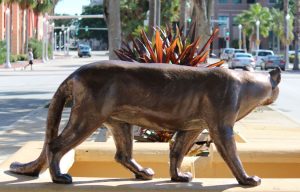 On October 1st, Chris-Tel Construction and Miami-based art conservators Rosa Lowinger & Associates began conservation of The Florida Panthers, a fountain-based installation in the median on Monroe Street between the post office and Harborside Event Center. Conservation of the three panthers has been completed, although work remains to be done on the
On October 1st, Chris-Tel Construction and Miami-based art conservators Rosa Lowinger & Associates began conservation of The Florida Panthers, a fountain-based installation in the median on Monroe Street between the post office and Harborside Event Center. Conservation of the three panthers has been completed, although work remains to be done on the 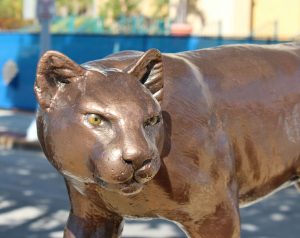 basins themselves to seal up a number of leaks.
basins themselves to seal up a number of leaks.
The installation features three Florida panthers, a male on the prowl, a reclining female and a cub sitting on a ledge next to a gargantuan bullfrog. The sculptures and related water features were created by North Fort Myers sculptor Don “D.J.” Wilkins at the request of the City of Fort Myers Beautification Advisory Board in 1988. Between 1982 and 2000, 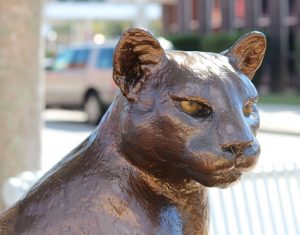 Wilkins installed 23 public artworks in Fort Myers and repaired two others (The Tootie McGregor Fountain in the parking lot of the Fort Myers Country Club off McGregor and The Spirit of Fort Myers at the entrance to Edison Park across from Seminole Lodge and The Mangoes in the Edison & Ford Winter Estates).
Wilkins installed 23 public artworks in Fort Myers and repaired two others (The Tootie McGregor Fountain in the parking lot of the Fort Myers Country Club off McGregor and The Spirit of Fort Myers at the entrance to Edison Park across from Seminole Lodge and The Mangoes in the Edison & Ford Winter Estates).
Several of Wilkins’ masterworks had fallen into disrepair over the last few years as the City’s Public Art Committee (PAC) 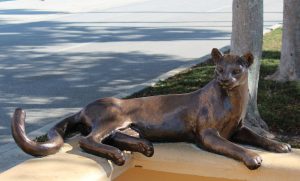 took over responsibility for administration and maintenance of the City’s public art collection from the Beautification Advisory Board. The Florida Panthers were one of the installations in need of some attention, but just as the PAC was preparing to engage Chris-Tel Construction and Rosa Lowinger & Associates to do the work,
took over responsibility for administration and maintenance of the City’s public art collection from the Beautification Advisory Board. The Florida Panthers were one of the installations in need of some attention, but just as the PAC was preparing to engage Chris-Tel Construction and Rosa Lowinger & Associates to do the work, 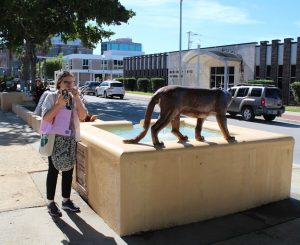 Hurricane Irma struck, wreaking further havoc on Wilkins’ cats in the median of Monroe Street.
Hurricane Irma struck, wreaking further havoc on Wilkins’ cats in the median of Monroe Street.
During the storm, a section of the male’s tail was broken off by a downed limb. Wind and flying debris opened a network of cracks in the female’s tail and hind legs. Prior to the storm, the cub’s head and tail were already broken. Irma claimed its front proper leg.
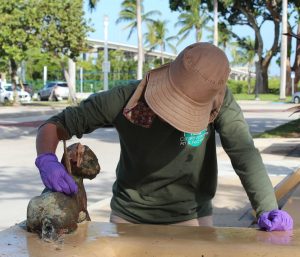 Reconstruction and replacement of the missing components complicated an already complex project. But Rosa Lowinger & Associates was up to the challenge. The cub looks as it did when it was originally installed, and changes were made to the male panther’s tail to protect it from future damage.
Reconstruction and replacement of the missing components complicated an already complex project. But Rosa Lowinger & Associates was up to the challenge. The cub looks as it did when it was originally installed, and changes were made to the male panther’s tail to protect it from future damage.
As originally cast, the male’s tail curled upward, putting it at risk for breakage from storm-driven debris, 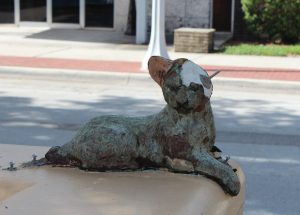 vandalism and damage caused accidentally by adults and children climbing or sitting on the walls of the water basin. Working in conjunction with the sculptor, the RLA conservators changed the tail to lay flat on the top of the basin wall so that it cannot be inadvertently snapped off.
vandalism and damage caused accidentally by adults and children climbing or sitting on the walls of the water basin. Working in conjunction with the sculptor, the RLA conservators changed the tail to lay flat on the top of the basin wall so that it cannot be inadvertently snapped off.
Before it was possible to reconstruct and replace the missing parts and inject epoxy into the cracks and fissures on all three 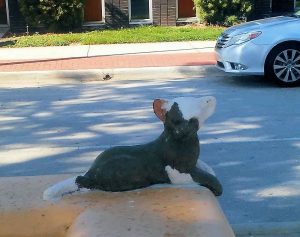 cats, RLA’s crack conservation team first had to strip off all of the paint and sealants to expose the underlying composite, which is made of cold cast bronze. Once the repairs were completed, RLA applied a primer designed to protect the metal resin followed by a marine-grade metallic top coat intended to seal the composite from the sun’s UV rays, heat, humidity and the chlorinated water that the white-water bubblers
cats, RLA’s crack conservation team first had to strip off all of the paint and sealants to expose the underlying composite, which is made of cold cast bronze. Once the repairs were completed, RLA applied a primer designed to protect the metal resin followed by a marine-grade metallic top coat intended to seal the composite from the sun’s UV rays, heat, humidity and the chlorinated water that the white-water bubblers 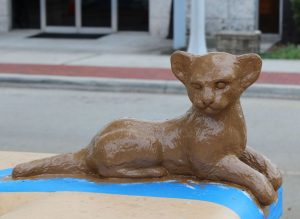 splash all over the panthers on a continual basis.
splash all over the panthers on a continual basis.
The bullfrog is yet to be replaced.
Wilkins kept one of the clay casts he used to make the frog, a figure he also incorporated into a number of his other artworks, including the Tootie McGregor Fountain and Uncommon Friends (the homage to Vagabonds Thomas Edison, Henry Ford and Harvey 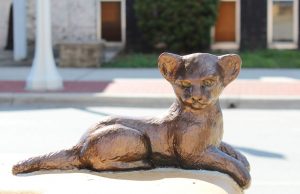 Firestone that sits at the entrance to Centennial Park East). A couple of weeks ago, he retrieved it from a storage unit that holds casts to a number of other sculptures and turned it over to RLA to assist in the restoration. RLA will use it to replace the frog that once sat next to the cub, as well as eight others that were either destroyed by Hurricane Irma or removed by scavengers
Firestone that sits at the entrance to Centennial Park East). A couple of weeks ago, he retrieved it from a storage unit that holds casts to a number of other sculptures and turned it over to RLA to assist in the restoration. RLA will use it to replace the frog that once sat next to the cub, as well as eight others that were either destroyed by Hurricane Irma or removed by scavengers 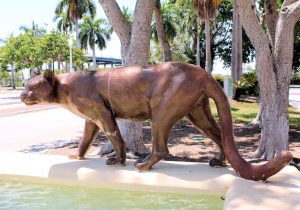 from the tidal pool in Uncommon Friends.
from the tidal pool in Uncommon Friends.
RLA and Chris-Tel Construction expect to complete the remaining work (fixing the leaks, waterproofing the basins and replacing the bullfrog) prior to February 1.
The panther is the Florida state animal. It was chosen for the honor 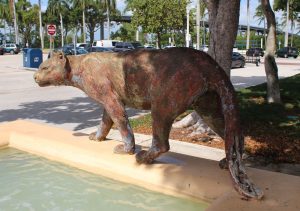 in 1982 by a vote of students throughout the state. As the plaque mounted on the side of the northern tidal pool states, the Florida Panther is on a “countdown to extinction.” Both the City of Fort Myers and the sculptor hope that The Florida Panther helps draw attention to the plight of this highly-endangered species.
in 1982 by a vote of students throughout the state. As the plaque mounted on the side of the northern tidal pool states, the Florida Panther is on a “countdown to extinction.” Both the City of Fort Myers and the sculptor hope that The Florida Panther helps draw attention to the plight of this highly-endangered species.
Rosa Lowinger & Associates specializes in the conservation 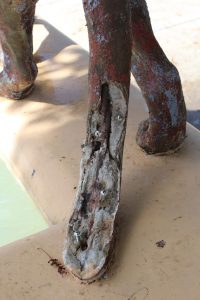 of built heritage, a term that encompasses art, architecture, museum collections, and public spaces. Rosa Lowinger is a recognized international expert in conservation and a specialist in modern and contemporary sculpture, architecture, and public art. She has been in private practice since 1988. Each of the company’s senior staff has been in practice for no less than 5 years and as a team, RLA has a combination of 50 years of experience carrying out conservation, cultural resource documentation, restoration, and historic remediation projects for architecture, public art, and sculpture in stone, masonry, concrete, metals, ceramic tile, terracotta, wood, plastic, plaster, terrazzo, linoleum and mosaics.
of built heritage, a term that encompasses art, architecture, museum collections, and public spaces. Rosa Lowinger is a recognized international expert in conservation and a specialist in modern and contemporary sculpture, architecture, and public art. She has been in private practice since 1988. Each of the company’s senior staff has been in practice for no less than 5 years and as a team, RLA has a combination of 50 years of experience carrying out conservation, cultural resource documentation, restoration, and historic remediation projects for architecture, public art, and sculpture in stone, masonry, concrete, metals, ceramic tile, terracotta, wood, plastic, plaster, terrazzo, linoleum and mosaics.
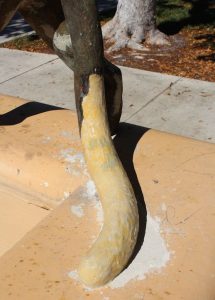 The Florida Panthers and each of the City’s other 69 public artworks are administered by a 9-member Public Art Committee (which consists of 7 voting members and 2 alternates) that was established by an ordinance that was adopted by the City Council in 2004. Members serve for three year terms, are not compensated, and must either be a resident of the city, work in the city, or be a member of an arts board or committee that is located in the city. The Public Art Committee oversees the commissioning, review, installation and maintenance of public art within the City. It meets in public session in City Council chambers on the third Tuesday of each month. Its next meeting is December 18.
The Florida Panthers and each of the City’s other 69 public artworks are administered by a 9-member Public Art Committee (which consists of 7 voting members and 2 alternates) that was established by an ordinance that was adopted by the City Council in 2004. Members serve for three year terms, are not compensated, and must either be a resident of the city, work in the city, or be a member of an arts board or committee that is located in the city. The Public Art Committee oversees the commissioning, review, installation and maintenance of public art within the City. It meets in public session in City Council chambers on the third Tuesday of each month. Its next meeting is December 18.
RELATED POSTS.













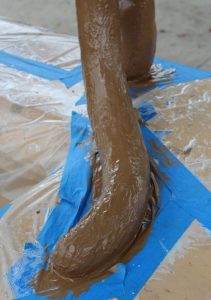

 Tom Hall is both an amateur artist and aspiring novelist who writes art quest thrillers. He is in the final stages of completing his debut novel titled "Art Detective," a story that fictionalizes the discovery of the fabled billion-dollar Impressionist collection of Parisian art dealer Josse Bernheim-Jeune, thought by many to have perished during World War II when the collection's hiding place, Castle de Rastignac in southern France, was destroyed by the Wehrmacht in reprisal for attacks made by members of the Resistance operating in the area. A former tax attorney, Tom holds a bachelor's degree as well as both a juris doctorate and masters of laws in taxation from the University of Florida. Tom lives in Estero, Florida with his fiancee, Connie, and their four cats.
Tom Hall is both an amateur artist and aspiring novelist who writes art quest thrillers. He is in the final stages of completing his debut novel titled "Art Detective," a story that fictionalizes the discovery of the fabled billion-dollar Impressionist collection of Parisian art dealer Josse Bernheim-Jeune, thought by many to have perished during World War II when the collection's hiding place, Castle de Rastignac in southern France, was destroyed by the Wehrmacht in reprisal for attacks made by members of the Resistance operating in the area. A former tax attorney, Tom holds a bachelor's degree as well as both a juris doctorate and masters of laws in taxation from the University of Florida. Tom lives in Estero, Florida with his fiancee, Connie, and their four cats.